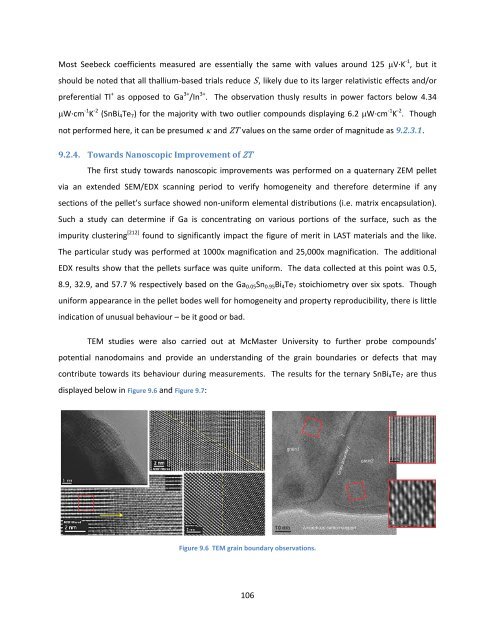Exploration and Optimization of Tellurium‐Based Thermoelectrics
Exploration and Optimization of Tellurium‐Based Thermoelectrics
Exploration and Optimization of Tellurium‐Based Thermoelectrics
Create successful ePaper yourself
Turn your PDF publications into a flip-book with our unique Google optimized e-Paper software.
Most Seebeck coefficients measured are essentially the same with values around 125 V∙K ‐1 , but it<br />
should be noted that all thallium‐based trials reduce S, likely due to its larger relativistic effects <strong>and</strong>/or<br />
preferential Tl + as opposed to Ga 3+ /In 3+ . The observation thusly results in power factors below 4.34<br />
W∙cm ‐1 K ‐2 (SnBi4Te7) for the majority with two outlier compounds displaying 6.2 W∙cm ‐1 K ‐2 . Though<br />
not performed here, it can be presumed <strong>and</strong> ZT values on the same order <strong>of</strong> magnitude as 9.2.3.1.<br />
9.2.4. Towards Nanoscopic Improvement <strong>of</strong> ZT<br />
The first study towards nanoscopic improvements was performed on a quaternary ZEM pellet<br />
via an extended SEM/EDX scanning period to verify homogeneity <strong>and</strong> therefore determine if any<br />
sections <strong>of</strong> the pellet’s surface showed non‐uniform elemental distributions (i.e. matrix encapsulation).<br />
Such a study can determine if Ga is concentrating on various portions <strong>of</strong> the surface, such as the<br />
impurity clustering [212] found to significantly impact the figure <strong>of</strong> merit in LAST materials <strong>and</strong> the like.<br />
The particular study was performed at 1000x magnification <strong>and</strong> 25,000x magnification. The additional<br />
EDX results show that the pellets surface was quite uniform. The data collected at this point was 0.5,<br />
8.9, 32.9, <strong>and</strong> 57.7 % respectively based on the Ga0.05Sn0.95Bi4Te7 stoichiometry over six spots. Though<br />
uniform appearance in the pellet bodes well for homogeneity <strong>and</strong> property reproducibility, there is little<br />
indication <strong>of</strong> unusual behaviour – be it good or bad.<br />
TEM studies were also carried out at McMaster University to further probe compounds’<br />
potential nanodomains <strong>and</strong> provide an underst<strong>and</strong>ing <strong>of</strong> the grain boundaries or defects that may<br />
contribute towards its behaviour during measurements. The results for the ternary SnBi4Te7 are thus<br />
displayed below in Figure 9.6 <strong>and</strong> Figure 9.7:<br />
Figure 9.6 TEM grain boundary observations.<br />
106
















